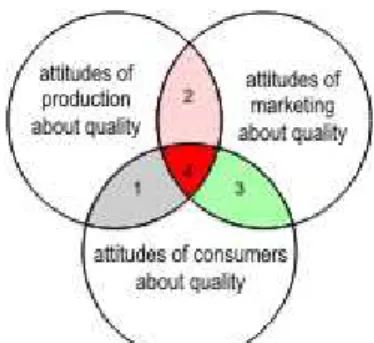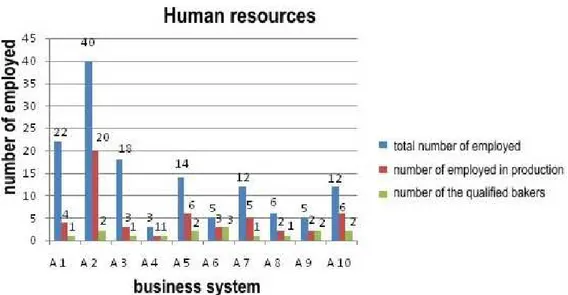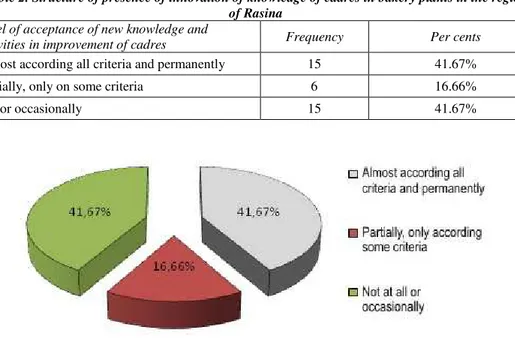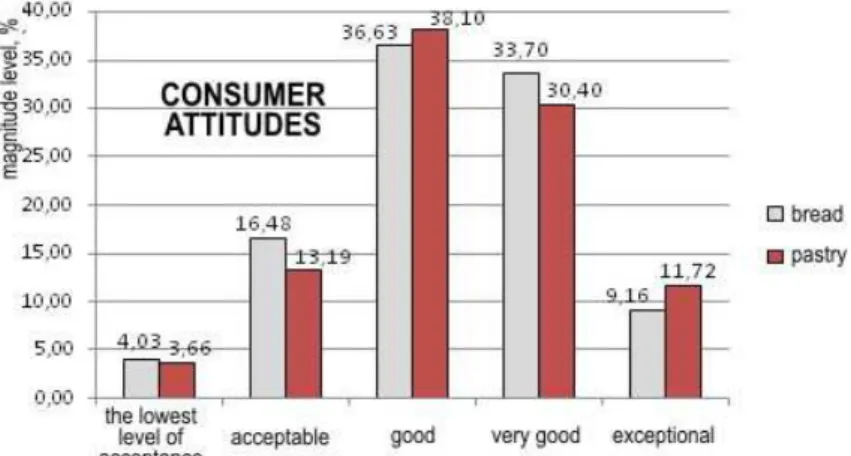International Journal for Quality research UDK- 378.014.3(497.11)
Short Scientific Paper (1.03)
Aleksandar Marić1)
Slavko Arsovski2)
Jasna Mastilović3)
1) Fakultet za industrijski menadžment, Kruševac,
Serbia
2) Faculty of Mechanical Engineering, University of
Kragujevac, Serbia
3) Tehnološki fakultet, Novi Sad, Serbia
Contribution to the Improvement of Products
Quality in Baking Industry
Abstract: Food industry occupies special place in the processing industry, especially when we talk on the manufacturing of bakery products. Variable products quality on the market initiated the authors of this study to make an attempt, using comparative analysis of methods for quality control that are at most applied in bakery plants and other „convenient“ methods to indicate the shortcomings and to argue convenience of using of methods that would improve testing of the quality. That approach could create a base for designing of model of quality improvement the baking industry.
Keywords: product quality, baking, sensory evaluation
1. INTRODUCTION
A Baking industry is characterized with a variety of different products that daily find their place on the market. Their quality estimate all possible generations of consumers. Stable quality of production, from the long-term point of view, is not easy to preserve. Position on the market are hardly gained, but very easily lost. In the case of so sensitive production such as the baking industry, in order of keeping of the existing positions, it is unavoidable to make all possible efforts for keeping of the achieved levels of competences. Competence is commonly expressed over three basic factors: the quality, the time and the price [1].these factors commonly represent basic – main criteria that determine consumer’s preferences for definite products. Nevertheless, consumers, which are accustomed with the conventional flavors, with already formed their own quality criteria, and being unable even to recognize distinctive sorts of bread, or to give judgments about its quality, represent the interested
customers of this industry, which are really not easy to satisfy. No educated with respect to quality, consumers very often do not know what they really seek [2]. But, the indicative fact, which is generally accepted, is that on the market one can meet distinctive oscillations of the product quality.
Goal of this work is to indicate the possible methods of estimation of products quality, whose choice could assure the demanded quality of baking industry products for the long periods of time.
2. PRODUCTS OF THE BAKING INDUSTRY
In the technological sense of word, bakery products are defined in the Legal rule- book on the quality of wheat, milling and baking products, pasta products and fast frozen doughs [7].
A. Marić, S. Arsovski, J. Mastilović
2
Bread is the product obtained by mixing, fermentation, forming and baking of dough obtained from basic raw materials such as: flours obtained from cereals, grists, water or other allowed liquids, baker’s yeast and other fermentation aims and table salt. With respect of the improvements of physical and sensory properties and shelf life of bread, the use of additives is allowed.
Pastries, in the context of the rule-book, are products similar to bread, but their weight per piece is not higher than 250 grams.
Other kinds of bakery products, in the context of the rulebook, are products obtained from basic and additional raw materials, as well as additives. These products have distinctive form and are processed by using of procedures differing from procedures used in production of bread and pastry.
Products that were objects of our investigations were bread and pastry. They were chosen, without tendencies of diminishing of the significance of other kinds of bakery products.
3. ANALYSIS OF BAKING INDUSTRY OF RASINA REGION FROM PRODUCT QUALITY, CADRE POTENTIALS, CUSTOMER ATTITUDES ON PRODUCT QUALITY POINTS OF VIEW
The most efficient way of generating of general attitudes about market products quality can be obtained through testing of quality in the whole chain of manufacturing, sales and consumption (market).
Each interested side has its own attitude about the quality and its own evaluation. By synergies of attitudes and evaluations of all mentioned participants it is possible in the fastest manner to recognize points of discrepancies, discover failures and recommend at the very first moment the corrective measures, and thereafter improvement and promotion measures. Such all-inclusive, integral approach to the problem can enable creation of new values owing to the quality promotion
Fig. 1. Superposing of attitudes on the quality : 1 – common attitudes (interests
for quality) of manufacturer and consumer; 2 – common attitudes of manufacturer and distributor (salesman);
3 – common attitudes of salesman and consumer; 4 – common attitudes of manufacturer, salesman and consumer Superposing of attitudes about quality is shown in the Venn diagram (Figure 1). Goal of such presentation is to stress out interrelations between the interested participants (production, marketing and consumers) oriented to common general aims – the quality, which each participant has to create.
However, results of investigations in frames of our study are related to the investigations oriented to manufacturers and market (consumers).
36 bakery plants in region of Rasina were included, as well as the sample of the market (consumers) that can be considered to be representative. The show results in the case of manufacturing refer to: magnitude of the business system, qualification structure of the employed (Table 1, Figure 2), and innovation of knowledge of the employed (Table 2, Figure 3).
Results related to the market (consumer) refer to attitudes and motivations for purchasing as well as on behavior of consumers with respect to fulfilling of their needs and demands.
Analyzing the structure of organizations in the region of Rasina with respect of the human resources (magnitude of the business system), we can find out that:
• 44.44 per cent of organization employs bellow 10 employed,
• 25 per cents of organizations has 10 – 15 employed,
• 13.90 per cents of organization employ more than 40 workers.
Hence, organizations represent predominantly small manufacturing – business systems.
Number of employed in the immediate production counts 38.36 per cents with respect
to the total number of the employed.
Number of qualified bakers and technologists with respect to total number of employed amounts to 10.48 per cents, and with respect to the number employed in production amounts to 27.18 per cents (Figure 2).
Fig. 2. Human resources structure in bakery plants in the region of Rasina
Table 1. Qualification structure of production workers in bakery organizations in the region of Rasina
Business system/ qualification structure of cadres Frequency Per cent Number of business systems that do not employ qualified workers
(technologists and/or qualified bakers) in the production 12 33,33% Number of business systems employing only qualified bakers 21 58,33% Number of business systems employing qualified bakers and
technologists 3 8,33%
A. Marić, S. Arsovski, J. Mastilović
4
Table 2. Structure of presence of innovation of knowledge of cadres in bakery plants in the regionof Rasina Level of acceptance of new knowledge and
activities in improvement of cadres Frequency Per cents Almost according all criteria and permanently 15 41.67%
Partially, only on some criteria 6 16.66%
No, or occasionally 15 41.67%
Fig. 4. Shares of education of cadres according to the Table 2 and the given criteria of bakery organizations in the region of Rasina
Criteria for innovation of knowledge that were mentioned are: participation on scientific – professional convention fairs of baking and equipment, following and acceptance of new knowledge from practice and references (professional journals, text books, internet), scholarships.
Investigations were performed in the Rasina region, with goals to find out the actual state of the baking industry. Communities of Krusevac, Aleksandrovac, Brus, Trstenik, Varvarin and Cicevac were included.
Number of the polled in the communities was chosen in such a way, as to approximately correspond to the magnitude of the community and to number of inhabitants in the Region of Rasina.
Women are carriers of purchasing in the family, and their attitudes can be projected to the choice of the family as the whole, having in mind that their choice during purchasing has to unite attitudes of all family members, so that they all have to be satisfied. Totally 273 families were polled, with totally 1145 of participants. Results presented in this work are only one part of the designed project with considerably broader frames, either from aspects of the predetermined scientific aims, or
from aspects of participants questionarried. The importance of bread for nourishment, consumers described with the following attributes:
• Main food10.26%, • Important 45.06%, • Very important 25,64%, • Less important 13.92%, and
• Negligible
4.40%.
It is clear that 81.68% of the polled population consider bred as being very important in the nourishment, and only 18.32% of population do not consider it as food of special importance.
Ranking of factors that have effects on
decision about purchasing of the product,
consumers priorities were as follows. 1. Product quality, 2. Product freshness, 3. Regular supplying,
4. Price 5. Assortment,
6. Kindness of salesmen, 7. Personal liability, 8. Packaging,
International Journal for Quality research UDK- 378.014.3(497.11)
Short Scientific Paper (1.03)
Fig. 5. Consumer attitudes about quality of baker’s products (bread and pastry) on the market
Key factors for the quality (attributes influencing the quality) of bakery products, according to the attitudes of consumers, are:
1.Raw materials quality, 2.Technology,
3.Sanitation, and
4.Baker’s knowledge and experiences. Quality parameters of bakery products, according opinions of consumers, ranked according their significance, are:
1.Flavor (odor and taste) 2.Appearance of crust, 3.Volume,
4.Keeping manner,
5.Choice of packaging and packaging procedure,
6.Symmetry of form.
The mentioned attitudes (Figure 5), evaluation procedures and importance of bakery products for the nourishment of consumers make represent guidelines of action, not only for manufacturers, but for all interested participants in the baking industry. Using these arguments, the authors of this article wanted to point out the significance of products with respect to consumers, and to contribute to the choice of the optimal methods of estimation of the products quality.
The most often applied method of quality control in bakery organizations in region of Rasina is the evaluation by scoring.
4. EVALUATION OF PRODUCTS QUALITY BY SCORING
Scoring system is used when it is
necessary to achieve complete sensory evaluation of some product. Particular product properties are scored with numerical values, and at that time, each property, i.e. the quality element, possesses the distinctive coefficient of importance. Score multiplied with the corresponding coefficient of importance gives total number of scores for the given element of quality. For such system of evaluation exist schemes with different numbers of scores, and as optimal number a scheme with scores between 20 and 50 can be adopted [4].
For applying of this method, the most significant is the properly estimation of coefficients of importance values for distinctive quality elements, in frames of the design, so that they correspond to their significance with respect to total quality of the product being evaluated. The role of coefficient of importance in sensory evaluation scheme is the avoidance of interfering of scores.
Flour-based products are specific because, besides to odor and taste, their quality largely depends on appearance and crumb texture. To be able to evaluate some product properly, panelist has to be familiar with basic characteristics of the product, and technology of its production.
During making the choice of the method of sensory evaluation, it should be kept in mind that „the best method“ never exists. The choice of the method primarily depends on results and purposes of evaluation.
International Journal for Quality research UDK- 378.014.3(497.11)
Short Scientific Paper (1.03)
Vol.3, No. 3, 2009 6
Scores Description Marks
> 40 41 – 60 61 – 80 81 – 90 91 - 100
Unacceptable for marketing Satisfactory
Good Very good Excellent
1 – 2 3 – 4 5 – 6 7 - 8 9 - 10
DATA ON THE EVALUATION OF BREAD (an example)
Name of the enterprise DP „Branko Perisic“, Krusevac Date und time of evaluation Apr. 13th, 2005
Sort of the product Bread, T-850
First name and name of evaluator Bogicevic Mihajlo
Sample label T-850
Declared mass 700g.
Measured mass 685 g. 712 g. 713 g. 714 g. 710 g.
Sample number 1 2 3 4 5
Quality elements
Coefficient of importance B
Ax
B B
Ax
B B
Ax
B B
Ax
B B
A x B
Appearance 3 3 9 4 12 5 15 5 15 5 15
Volume 4 5 20 5 20 5 20 5 20 5 20
Crumb appearance
5 4 20 4 20 4 20 4 20 3 15
Crust and crumb odor
3 4 12 4 12 4 12 5 15 4 12
Crust and crumb taste
5 4 20 4 20 4 20 4 20 4 20
Total sum of
scores 20 81 84 87 90 92
Notes: A = Coefficient of importance; B = Assigned marks for the quality element; a x B = Number of scores
The following histogram shows application of control of the finished products quality in the baking enterprises in the region of Rasina (Figure 6).
Fig. 6.Quality control in the baking industry in the region of Rasina
As it can be seed, some 5.5 per cents of organization perform almost not the control of their finished products quality, what represents
estimation of the quality, without any defined parameters that could be measured (for instance, in internal laboratory of the plant). These organizations do not apply any external control, even not in the Institution for protection of human health. The remaining 96 per cent of organizations perform integrity controls of their production in the Institution for human health protection, but only 9.1 per cents of organizations has their own laboratory for the quality control.
Therefore, our investigations show that the problem of quality control in bakery plants in the region of Rasina is to be recognized as one of the most serious problems.
5. CHOICE AND ANALYSIS OF CONVENIENT METHODS FOR EVALUATION OF THE
QUALITY
For obtaining of the all-inclusive and detailed data concerning sensory characteristics of bread for its evaluation purposes, whole set of different possibilities exists. The choice of the most appropriate method, which could lifer optimal results prom their significance point of view, depends of the facts that determine for which purposes are such results needed.
When considering consumer attitudes, first of all hedonic methods are applied. They require a sample of consumers which is statistically large enough for elaboration of questionnaire results. Such panels have to contain 50 polled subjects, or more. Because of that, tests have to be designed so that they give clear formulation of tasks, so that the questionarried would not have any dilemmas. Tests have to be performed in short period of time, under circumstances that require not special environment condition [5]. For investigations are normally applied tests with paired samples or triangle tests, where consumers are asked to make their preference with respect to question „which of the two products is better?, or „which of three products is different with respect to the other two?.
On the other hand, for the purposes of development of bakery products, it is unavoidable to apply methods of sensory
estimations with more details describe sensory properties, and for evaluations, tested, trained, experienced panelists have to be used [6]. In such cases, different aspects of sensory evaluations are considered, using visual, olfactory, gustatory and palpatory techniques that enable detailed judgment of particular quality aspects.
Visual technique of evaluation of sensory properties lifers data on the products appearance, inclusive their correctness and acceptability, as well as product color, its hue, brightness and homogeneity. Visual technique lifers also numerous data related with cut of the bread, beginning with the crust thickness, over connection of crust and crumb, till to the bread crumb, including one more its hue and color homogeneity. The special significance for the development of the products, from the point of view of visual evaluations, have judgments referring to the crumb structure, including its homogeneity, equality, size and fineness of porosity of the crumb.
Palpatory technique lifers for bread the data that reflect its crumb properties, such as moisture, crumbliness and elasticity, and for crust, palpatory technique lifers data on its brittleness and softness.
Evaluation of bread with olfactory technique means the obtaining of data on flavor, note and intensity of odor of products. Gustatory technique lifers the data on the strength and note of taste, on chewiness and fatness of the product.
4. CONDUSION
A. Marić, S. Arsovski, J. Mastilović
8
REFERENCES:
[1] Marić A., Đorđević Lj, Robajac O.: Technological process influence on product quality,
Proceedings of 14rd International Scientific Conference , CO-MAT-TECH 2006, Trnava, 19.-20. October 2006., page (817-823), Slovakia
[2] Marić A., Đorđević Lj., Arsovski S.: Quality analysis techniques and logistics in
technological systems,Proceedings of 8rd International Conference “RESEARCH AND DEVELOPMENT IN MECHANICAL INDUSTRY”- RaDMI 2008, Užice - Serbia and Montenegro, 14. – 17. September 2008. (Page 499 – 504)
[3] Kaluđerski, G.,Filipović, N.: Metode ispitivanja kvaliteta žita, brašna i gotovih proizvoda, Tehnološki fakultet, Novi Sad, 1998.
[4] Mastilović, J., Pestorić, M., Sakač, M., Pojić, M., Savković, T., Popov-Raljić, J. (2007). Savremeni pristup vrednovanja senzorskih svojstava prehrambenih proizvoda na tržištu. Ekonomske teme, XLV(1), 71-78.
[5] Živković, J., Mastilović, J., Pestorić, M. (2007). Vrednovanje stavova i zadovoljstva
potrošača hleba kao masovnog proizvoda. Žito-hleb 34, 109-113.
[6] Pestorić, M. Pojić, M., Mastilović, J. Šimurina, O., Tasić, T., Živančev, D. Šoronja
-Simović, D. (2008). Influence of sensory evaluation of traditional bread in Vojvodina.
Food processing, quality and safety 35, 3, 99-111.



